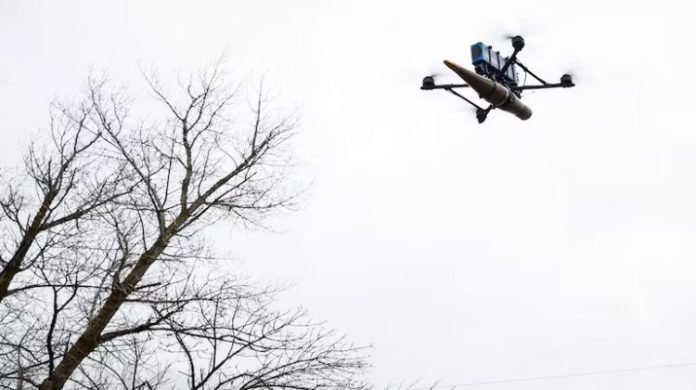Operation Sindoor marked a decisive leap in India’s warfighting evolution, where unmanned precision strikes, real-time ISR loops, and autonomous drone systems fused to deliver kinetic and psychological impact in record time. The operation not only validated India’s ability to execute ‘precise mass’ warfare but also exposed critical systemic gaps that must be addressed to institutionalise drone-enabled operations. Drawing on lessons from Ukraine’s battlefield innovation, China’s doctrinal integration, and India’s indigenous experiences, this article advocates a doctrinal, technological, and industrial transformation to position India at the forefront of autonomous warfare.
Operation Sindoor: India’s Drone Doctrine Takes Flight
The April 2025 Pahalgam terror attack triggered a swift tri-service response: Operation Sindoor, India’s first integrated drone-led precision campaign. Over a 72-hour window, FPV drones, loitering munitions, and quadcopters executed over 120 cross-LoC strikes with minimal troop exposure. ISR drones mapped infiltration routes, while kamikaze UAVs neutralised launch pads and military nodes. This was not a mere tactical success; it represented India’s first operational kill-web, integrating ISR, targeting, strike, and feedback in a coherent, machine-speed loop.
India’s strategic community recognised this as a Rubicon moment; a proof that autonomous systems could not only supplement conventional power, but reshape the kinetic grammar of limited war. Yet, despite this success, Sindoor revealed fragilities: overdependence on imported platforms, lack of modular indigenous drone kits, and fragmented command structures. Institutionalising these lessons into policy and doctrine is now an urgent national imperative.
Learning from Ukraine and China: The War of Innovation
Ukraine’s drone evolution has become a template of wartime adaptation. Facing a technologically superior adversary, Kyiv bypassed its conventional procurement channels and embraced commercial-off-the-shelf (COTS) innovation. It empowered frontline units to procure from approved drone vendors, utilised Starlink-style satcoms to coordinate swarms, and scaled drone usage from platoon ISR to deep-strike loitering missions.
Ukraine has mobilised over 300 drone tech start-ups and established a full-fledged Drone Forces Command. Platforms are tested in real battles: transformation in contact, refined via feedback loops, and deployed at scale within weeks.
In contrast, China’s drone doctrine is built on deliberate state-industrial synergy. With over 60 drone-focused institutes and a civil-military fusion model, China integrates uncrewed aerial systems (UAS) into all levels of operational planning. At the LAC, PLA UAVs perform ISR, swarm training, and terrain mapping in Tibetan high-altitude zones. Beijing has doctrinally embedded drone warfare within its informatised and intelligentised warfare paradigms, often pairing drones with AI-powered EW and decoy systems.
Both Ukraine and China exemplify two pathways: innovation from necessity and innovation from design. India must forge its hybrid doctrine, rooted in battlefield insight but driven by strategic foresight.
Despite success, Sindoor revealed fragilities. Overdependence on imported platforms, lack of modular indigenous drone kits, and fragmented command structures. Institutionalising these lessons into policy and doctrine is now an urgent national imperative
The Sindoor Doctrine: Institutionalising ‘Precise Mass’ Warfare
The central innovation of Operation Sindoor was the demonstration of ‘precise mass’; the mass deployment of swarms of affordable, semi-autonomous systems, delivering effects typically reserved for high-end missiles and aircraft. The strategy is simple: overwhelm defences through numbers, coordination, and resilience-saturation attacks.
Precise mass is different in that it involves not only volume, tempo, and precision, but also coordination and attritability as opposed to the traditional precision that was based on the few exquisite weapons to strike high-value targets surgically. The mission will still succeed even if 30 per cent of the swarm survives. Saturation over resilience leads to physical and psychological paralysis. This reverses the cost calculus of war, making defence expensive and offense cheap.
India showcased this potential partially, but the strategy demands institutional embedding. Without robust C-UAS systems, trusted domestic supply chains, and doctrinal reforms, precise mass will remain episodic, not systemic.
Structural Gaps in India’s Drone Warfighting Capability
- Centralised Procurement Paralysis
India’s drone acquisitions remain stuck in bureaucratic cycles. General Staff Qualitative Requirements (GSQRs) often lag behind frontline needs. What we need is a simple CGOE (capability guidelines and operation employment) rather than voluminous, complex GSQR/PSQR. DRDO’s innovation, while technologically sound, is disconnected from real-time operational theatres and deep integration for evolving a defence ecosystem. Meanwhile, iDEX-funded start-ups face delays in post-trial procurement and preferential treatment to big fish, thus undermining start-up investor confidence and innovation velocity. The concept of indigenous content and technology mapping also has several loopholes.
- Civil-Military-Tech Disconnect
Ukraine’s strength lies in battlefield-tech developer feedback loops. In India, soldiers rarely talk to engineers. Innovation is trapped in prototypes. The Armed Forces lack battlefield testbeds for TRL-7+ systems, and most acquisitions focus on platforms rather than plug-and-play systems.
- Imported Vulnerabilities
A large percentage of India’s drone sensors, GPS modules, and flight controllers are sourced from untrusted vendors, including Chinese origin. This creates vulnerabilities in jamming, backdoor entry, and mission integrity.
- Fragmented Command Architecture
India lacks a unified doctrine for drone operations. Some formations experiment with drones, but there is no tri-service integration. Sindoor was successful because it was led under a mission-specific task force; replicability demands a formal joint command.
Ukraine’s drone evolution has become a template of wartime adaptation. Facing a technologically superior adversary, Kyiv bypassed its conventional procurement channels and embraced commercial-off-the-shelf (COTS) innovation
Strategic Recommendations: From Sindoor to Supremacy
Establish a Tri-Service Unmanned Aerial Warfare Command
Led by the CDS, this command should oversee the development of unarmed system force, doctrine integration, wargaming, and inter-service operability. It must align procurement, innovation, and operational doctrine under a single roof. Further, the Artillery Division must have a Missile and Drone Brigade for each theatre, while FPV and short-range Kamikaze drones/swarms are allotted at brigade and unit levels.
Replace GSQRs with the Capability Guidelines Operational Environment (CGOEs) Model
Instead of rigid specifications, CGOEs define operational objectives — ‘track a target across 5 km of jungle in low light’, allowing diverse vendors and configurations to compete. The desired capability and operational environment must be defined, leaving the rest to vendor interaction and innovation.
Build Multi-Domain Task Forces (MDTFs) with Embedded Drone Units
Following the US Indo-Pacific MDTF model, Indian MDTFs should be formed in both Western and Northern theatres, with integrated drone, EW, cyber, and kinetic teams. These MDTFs will become the vanguard of India’s drone-enabled deterrence. The naming of the next-generation Integrated Battle Groups as RUDRA is a step in the right direction.
With over 60 drone-focused institutes and a civil-military fusion model, China integrates uncrewed aerial systems into all levels of operational planning. At the LAC, PLA UAVs perform ISR, swarm training, and terrain mapping in Tibetan high-altitude zones
Institutionalise the A3I2 Model: Acquire, Adopt, Adapt, Integrate
- Acquire commercial drones from vetted allies and domestic vendors.
- Adopt them into current formations with minimal latency.
- Adapt for terrain-specific missions—desert, high-altitude, urban.
- Integrate into the broader ISR-strike-logistics loop with doctrinal clarity.
Create Field Drone Nodes (FDNs) and Tactical Drone Clusters
FDNs should function as modular drone labs, testing payloads, jamming resistance, and fieldable customisations. Tactical Clusters (at battalion/brigade level) should receive dedicated drone packs — FPVs, ISR units, swarm kits.
Set up a ₹30,000 Crore Drone Warfare Innovation Fund
Jointly run by the MoD, iDEX, and Services, this fund should focus on:
- Scale-up grants to TRL-8+ platforms.
- Plug-and-play modular systems.
- Public-private joint IP rights.
- Indigenous replacements for foreign subsystems (sensors, communications, FCS, AI).
- Invest in next-generation R&D
India’s drone acquisitions remain stuck in bureaucratic cycles. iDEX-funded start-ups face delays in post-trial procurement, undermining investor confidence and innovation velocity. The indigenous content and technology mapping has loopholes
Evolve a doctrine of drone-integrated warfighting
Three lines of effort: build the force capability, optimise force readiness (effectiveness and preparedness), and force design – integrate into the structure
Accelerate C-UAS Ecosystem Development
India must deploy multi-layered counter-drone systems across:
- LAC and LOC: Capability and capacity for soft and hard kill options with technology- AI and seamless redundant C5ISR integrated.
- Vital Areas and Vital Points: Command, communication and control hubs, airfields, nuclear installations, oil refineries, etc.
- Urban Populations (VIP zones, mass events).
Directed Energy Weapons (DEWs), RF-denial systems, high-powered microwave (HPM) disruptors, and AI-enabled EO-IR classification systems must draw investment and induction.
Formalise Drone Warfighting in Professional Military Education
- Core curriculum on drone warfare ethics, swarm strategies, and autonomy laws.
- Technology and tactics dovetailed.
- Wargames and field-level exercises integration.
A large percentage of India’s drone sensors, GPS modules, and flight controllers are sourced from untrusted vendors, including Chinese origin. This creates vulnerabilities in jamming, backdoor entry, and mission integrity
Towards Sindoor 2.0: Regional Threatscapes and Preparedness
Western Theatre (Pakistan)
- Use of loitering munitions in semi-urban terrain.
- Precision ISR and drone-aided CT operations in border zones.
- Saturation drone strikes to neutralise launch pads and hideouts.
Northern Theatre (China)
- Deployment of terrain-following high-altitude drones.
- Drone-based forward sensors for troop movement detection.
- Swarms as A2/AD tools to deny PLA ingress in contested valleys.
Maritime Domain
- Ship-launched swarm ISR kits.
- Kamikaze drones against fast attack crafts and underwater sensors.
- Drone-aided island denial in A&N theatre.
Directed Energy Weapons (DEWs), RF-denial systems, high-powered microwave (HPM) disruptors, and AI-enabled EO-IR classification systems must draw investment and induction
Conclusion: Innovate or Be Outpaced
The age of drone-enabled conflict is no longer theoretical. Operation Sindoor has shown India what is possible; the Ukraine war shows what is scalable. The next round of conflict, whether Galwan 2.0 or Sindoor 2.0, will be fought by autonomous systems operating in machine time alongside manned systems. India’s enemies, state and non-state, are already adapting.
India’s response must be institutional, scalable, and doctrinally aligned. Precise mass, swarm warfare, AI enablement, and autonomous ISR-strike kill chains are not future options; they are present necessities. To hesitate now is to concede future initiative.
India must move from episodic success to systemic superiority. That journey begins with seizing the swarm and writing its doctrine.
The author, a PVSM, AVSM, VSM has had an illustrious career spanning nearly four decades. A distinguished Armoured Corps officer, he has served in various prestigious staff and command appointments including Commander Independent Armoured Brigade, ADG PP, GOC Armoured Division and GOC Strike 1. The officer retired as DG Mechanised Forces in December 2017 during which he was the architect to initiate process for reintroduction of Light Tank and Chairman on the study on C5ISR for Indian Army. Subsequently he was Consultant MoD/OFB from 2018 to 2020. He is also a reputed defence analyst, a motivational speaker and prolific writer on matters of military, defence technology and national security. The views expressed are personal and do not necessarily carry the views of Raksha Anirveda






